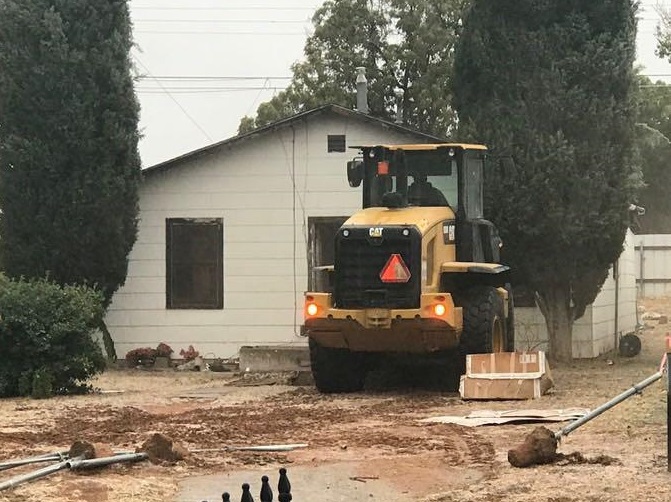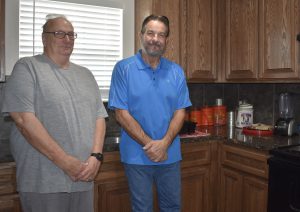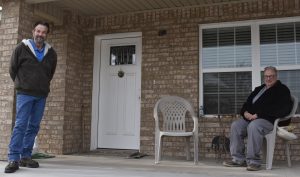
Year after year, Gary Snedegar suffered through Odessa’s brutal summers and winters. His window A/C unit couldn’t keep up with the heat and humidity most months and the cold air just whipped through his drafty windows the other months.
As if that wasn’t enough, his ’50s-era home on North Tom Green Avenue didn’t have adequate water pressure, the floors were cracked and unlevel, the electricity was unreliable and the roof was in terrible shape.
His cousin, Bobbi Donaldson, suggested he reach out to the City of Odessa to see if the Community Development Department could lend a hand.
Bill Talley inspected it and quickly decided it was a classic case of good news, bad news.
The bad news was there was no way to save the home.
The good news was Snedegar qualified for a program that would allow the City of Odessa to raze it and build an entirely new one for him on the same property.
Just a little over a year ago, Snedegar was handed the keys to his brand new, 1,100-square-foot, two-bedroom, one-bath house.
“I cried when I walked in and seen it,” Snedegar, 66, said.
His favorite features?
“The kitchen, the dining room and the bedrooms and the bathroom is a lot better than my old bathroom,” Snedegar said. “The bathroom was so small in the old house. I like my walk-in shower. I love that.”
Merita Sandoval, director of community development and code enforcement for the City of Odessa, said every year the city receives roughly $500,000 from the U.S. Department of Housing and Urban Development to spread over four different city programs.
In addition to the reconstruction program Snedegar was a beneficiary of, the city has minor repair, emergency repair and rehabilitation programs for those city residents who qualify.
An individual or family who earns 80% or less of the area’s median income might be able to get immediate help getting their furnace fixed or a severely leaking roof fixed, for instance.
Sandoval said a resident recently received help after going two years without water or electricity. She was carrying in water for sponge baths, drinking and flushing her toilet.
“I don’t think some people have any idea of how some of our citizens live. I don’t think they have a clue,” Sandoval said.
People in the same income level could also qualify for help getting less urgent repairs done, Sandoval said. For example, they could get energy efficient windows or insulation.
Snedegar, because he owned his home outright and fell in the right income-range, was eligible to have his home either rehabilitated or reconstructed.

Last year was a bit of a slow year with only seven families benefiting from the programs, but five homes are being worked on right now, Sandoval said. Another six are pending.
On Tuesday, Sandoval will ask the Odessa City Council to transfer $243,333 in federal funding from an unused infill housing construction program to her rehab/reconstruction budget.
Last week Sandoval told the council she’s seen a “major influx” of people seeking help with repairs and the transfer will help accommodate them.
“That will free up some of our Community Development Block Grant money so we can do minor repairs,” Sandoval told the council.
Sandoval explained once the construction is done, the city requires the homeowners to purchase homeowners insurance. She also noted the city takes out a 15-year lien on the property, but what the homeowner pays depends on their income level.
“Most of them are 100% forgiven over the 15 years,” Sandoval said. “We have pay back levels that are zero, 25, 50, 75 and 100% and our interest rates are 1, 2 and 3%, but very few have to pay anything back.”
Talley designs all of the new homes and oversees the contractor to make sure the city is meeting all of the required codes for new construction, Sandoval said.
Snedegar and others like him are given options when it comes to bricks, paint, floor stains and roofing colors, she said.
During a tour at Snedegar’s recently, Talley pointed out the city was required by FEMA to lift the home out of the flood plain. He also showed off Snedegar’s custom-built cabinets, numerous storage spaces and laundry room.
The kitchen counters are granite because they’ll last longer and all of the homes are built with 36-inch doorways and other handicap features, Talley said.
The homes also have energy efficient features, as well, from the lights, to the appliances to the insulation, he said.

“I design these homes with two-by-six walls instead of two-by-fours so we get more insulation in the walls. We get more insulation in the rafters because we do a foam envelope. We spray foam everything on the exterior and in the roof so it completely encapsulates the whole home in foam. That keeps the heating and cooling bills to a minimum,” Talley said.
Snedegar is now well set for the future, Talley said.
“He’s pretty much in a home that he can stay in, more comfortable, for the rest of his life. It’s virtually maintenance free,” Talley said. “The whole exterior is brick and vinyl and metal. The interior is very comfortable because of the way we construct it.”
Although the reconstruction jobs can be challenging, like those in flood plains, Talley loves his job.
”The good thing about the program is that it helps the people that really live in conditions that they shouldn’t be living in. Most of the people that we deal with are elderly people. They get into a situation where they cannot fix the home that they live in,” Talley said.



